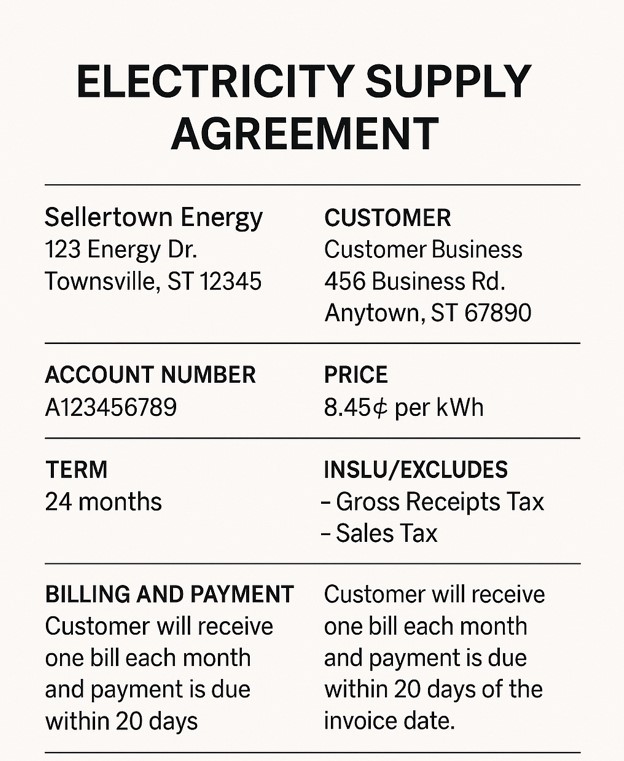Electricity Supply Agreement

🔌 What Is an Electricity Supply Agreement?
An Electricity Supply Agreement is a contract between you (the business) and a supplier to buy electricity at a certain price for a specific period of time. It’s NOT from your utility; it’s from a competitive supplier in a deregulated market.
✅ What’s Usually Included in the Supply Rate?
Your supply rate (the price per kWh you pay) might include several parts, or just a few depending on how the deal is set up.
Here’s what might be included in your rate:
1. Energy (Supply)
-
This is the actual electricity you’re using.
-
Always included.
2. Capacity
-
Think of it like a “reservation” on the grid paying to have enough electricity available for peak demand.
-
May be included in your rate or passed through (extra charge).
3. Ancillary Services
-
These are small services that keep the power grid running smoothly (like backup and frequency control).
-
Often included, but ask to confirm.
4. Transmission
-
The cost to send electricity over high-voltage lines to your utility.
-
Might be included or passed through separately.
5. GRT (Gross Receipts Tax)
-
A tax on the supplier’s revenue from selling electricity.
-
Some suppliers include this, others add it as a separate line on your bill.
❌ What’s Usually Not Included in the Supply Rate?
1. Sales Tax
-
State or local tax on your total electricity bill.
-
Usually NOT included in your rate. It’s added later unless you're tax-exempt (like some nonprofits or manufacturers).
2. Utility Delivery Charges
-
You still get charged by your local utility to deliver electricity through poles and wires.
-
That part stays separate unless you're on a "single bill" program (see below).
📦 What Other Options Should You Ask About?
🔁 100% Swing (a.k.a. “Full Requirements”)
-
This means your price stays the same no matter how much energy you use.
-
If you use more or less than expected, there’s no penalty.
-
Important if your usage changes month to month (like seasonal businesses).
📃 Pass-Through Items
-
Some suppliers offer lower base rates but charge extra for things like capacity, transmission, or GRT.
-
Others bundle everything into one rate, which is easier to manage.
🧾 One Bill vs Two Bills
✅ One Bill (Consolidated Billing)
-
You get one bill from your utility. It includes both the supply and delivery charges.
-
Easier to manage.
❌ Two Bills
-
One bill from the utility (for delivery).
-
One bill from the supplier (for energy).
-
More to track, but sometimes it’s required.
✅ Quick Checklist: What to Look For
Before you sign an agreement, ask:
-
🔍 Is the rate fixed or variable?
-
💡 Is capacity included?
-
🛠 Is transmission included?
-
🔁 Is it 100% swing (so I don’t get penalized for usage changes)?
-
🧾 Will I get one bill or two bills?
-
💸 Is GRT included?
-
🏷 Is sales tax included or will it be added later?
-
📆 What is the length of the contract?
-
🚫 Are there early termination fees?
🧠 Final Tip:
If you don’t understand every part of the agreement, ask the supplier or broker to explain it. Always get in writing what’s included in the rate so there are no surprises later.

